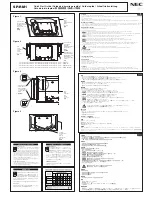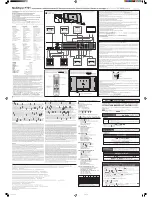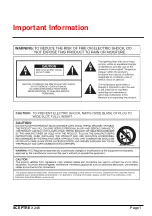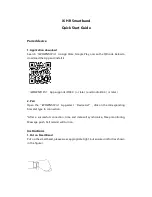
7
012208
10.0 TROUBLESHOOTING
The X90 is constructed to require the minimum of
maintenance. Operated properly, it should not require
any maintenance for a considerable period of time.
Any necessary troubleshooting should start with the
power supplies. Ronan Engineering suggests that a
voltmeter with a resistance of at least 20 kohm/V be
used for measurement of voltages. Verify that the power
supplies are working before starting with the rest of the
circuitry.
If the relay circuit works properly using the ZERO control,
check the operation of the detector with the source ON
and OFF to see if the tube responds.
For any major faults, we suggest the X90 be returned to
Ronan Engineering for service.
—————————————————————————
11.0 RADIATION SAFETY
The information in this section is intended for specific
licensees. The regulations and instructions pertain to
leak test and other procedures, which specific licensees
are authorized to perform. For general licensees this
section is included for information purposes only.
Most radioactive material used in gaging devices is
regulated by the United States Nuclear Regulatory
Commission (NRC). The NRC issues licenses to users
and manufacturers of gaging devices utilizing radioactive
materials and inspects sites where materials are used to
determine compliance with the terms of the license.
The NRC has issued rules on:
a) instructions to employees (10 CFR part 19);
b) the licensing of radioactive materials and devices (10
CFR part 30); and
c) radiation safety (10 CFR part 20).
During 1962, the NRC began entering into agreements
with individual states to transfer regulatory authority to
them. Known as “agreement states,” their regulations
closely parallel those of the NRC and are essentially
identical, except that the agreement states usually
regulate the use of all radiation-producing devices.
NOTE: Only those individuals specially licensed to
mount, repair, relocate and/or remove the part of the
gage containing the radioactive source may do so. Each
specific licensee should carefully read his particular
license to determine the exact conditions of his license.
Gamma-emitting radioactive material radiates
electromagnetic energy which is similar to light, except
that it readily penetrates opaque materials and is able to
pass through several inches of steel or other dense
material.
The ability to penetrate dense material can be used to
advantage in the measurement of process variables
such as density, level and thickness, where a change in
detected radiation indicates a change in process
variable.
Radiated energy is harmful to the human body when
absorbed at an excessive rate. For example, a glowing
incandescent lamp cannot be held in the hand without
causing severe discomfort or a painful burn. The hand
can be held close to the lamp for seconds, at a few
inches for hours or several feet away continuously. By
use of insulation surrounding the lamp or hand, the lamp
could be held indefinitely without discomfort or injury.
Radioactive energy and radiation is analogous to light
energy and radiation with the radioactive source taking
the place of the incandescent lamp. Permissible human
exposure to a radioactive source is dependent upon:
a) the number of millicuries of radioactive material in the
source (similar to the wattage rating of a lamp);
b) distance from the source;
c) amount of absorber between source and body;
d) amount of portion of the body receiving the radiation.
The term
milliroentgen per hour
(mR/hr) is a measure of
the radiation field intensity in air. When radiation is
absorbed by the body, the term
rem
or
millirem
(0.001
rem) is used. This distinction is necessary because not
all radiation affects the body in the same manner. For
gamma radiation, the millirem (mrem) is equal to the
milliroentgen.
The NRC limits the amount of radiation which a person
should receive to 1.25 rem per calendar quarter. This is
an average of about 100 mrem per week.
The 1.25 rem per calendar quarter limitation is a dose at
which there is no possibility of injury. However, since the
use of gamma radiation is relatively new, the history of
injury is not complete. Thus, it is wise to receive as little
radiation as possible. To guard against possible
overexposure and to maintain a record of personnel
routinely exposed to radiation, the NRC requires
monitoring of persons who are apt to receive more than
an average of 25 mrem per week or who are exposed to
a radiation field greater than 100 mr/hr. When personnel
monitoring is required, a record must be kept showing
the dose received. When records are kept, and if an
employee requests it, the employer must furnish a
written report of radiation exposure annually and on
































